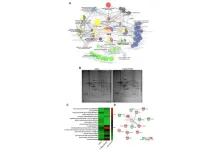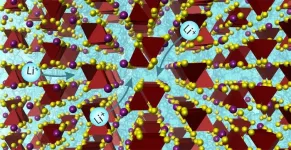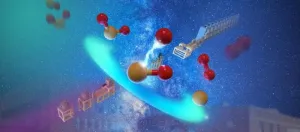(Press-News.org) A new study published in Atmospheric Environment by researchers at the University of North Carolina at Chapel Hill analyzed space and time trends for fine particulate matter (PM2.5) in the continental United States to track the progress of regulatory actions by federal, state and local authorities aimed at curbing air pollution. The team found that while the annual average concentration for PM2.5 had been significantly reduced, its chemical composition had changed during the study period of 2006 to 2020. Their analysis suggests targeted strategies to reduce specific pollutants for different regions of the U.S. may be more effective in further reducing total air pollution and PM2.5 -related adverse health effects. PM2.5, an airborne pollutant, is a mix of multiple chemical species and includes fine particles less than 2.5 microns in size. PM2.5 has been linked to many adverse human health effects including premature death. It also can reduce visibility by creating haze in the air.
“The results from this study are especially timely given the EPA’s revision of the health-based standard for PM2.5 from 12 µg/m3 to 9 µg/m3 that was just announced this month,” said Saravanan Arunachalam, senior author of the study and deputy director of the UNC Institute for the Environment. “States with monitors that are exceeding the new standard for PM2.5 will be looking to understand the chemical constituents of PM2.5, and how they have changed over time, and this will be key to developing emissions reductions policies to address potential future nonattainment designations.”
Using data from the U.S. EPA Air Quality System (AQS), the research team assessed trends across the 48 contiguous U.S. states. Chemicals found in PM2.5 in the U.S. include sulfate, ammonium, nitrate, organic carbon, elemental carbon and other trace elements, which come from a variety of human-created and natural sources.
The biggest air quality improvements during this 15-year period that was analyzed were observed in areas with the worst baseline air quality. The Ohio Valley and southeastern states, for example, had the biggest improvements due to regulations on emissions sources such as coal-burning power plants and industry. Sulfur dioxide emissions, a byproduct of fossil fuel combustion, decreased 91.5% from power plants during the study period. Most of the sulfur dioxide emissions in the study came from the Ohio Valley and the southeastern U.S. A spike in poor air quality along the West Coast in 2020 was likely due to widespread forest fires.
Although across the U.S. sulfate and ammonium levels have declined, the researchers suggest looking at mitigating other sources of carbon in the environment to further improve air quality, given the increasing contribution of carbon to total PM2.5. High pollution days have waned in recent years, but primary organic carbon peaked during winter months due to the reduced formation rate of secondary organic aerosols at low temperatures.
These regional differences, the researchers point out, show that regionally targeted approaches to air pollution mitigation will further improve the country’s air quality and decrease healthcare expenses for air pollution-related health issues and further save human lives.
“Different chemical constituents of PM2.5 are linked to various emissions sources, thus, the development of future emissions control strategies to reduce PM2.5 concentrations should be based on the comprehensive analysis of spatiotemporal trends of PM2.5 chemical composition and deep understanding of the relationships between changes in emissions and ambient concentrations,” said Bin Cheng, a co-author and research associate at the Institute.
“The results from this study will also contribute to future epidemiological studies to identify specific PM2.5 components that affect human health more than others,” added Arunachalam.
END
New study by researchers at UNC-Chapel Hill finds chemical composition of US air pollution changed over time
2024-02-15
ELSE PRESS RELEASES FROM THIS DATE:
ASHG names Amanda Perl as Chief Executive Officer
2024-02-15
For Immediate Release: Thursday, February 15, 2024, 3:00pm U.S. Eastern Time
Media Contact: Kara Flynn, 202.257.8424, press@ashg.org
ROCKVILLE, MD - The American Society of Human Genetics (ASHG) is excited to announce the selection of Amanda Perl as the organization’s next Chief Executive Officer. Perl has served in numerous association leadership positions with deep experience in strategic planning, membership, publishing, communications, and society operations, as well as meetings and conferences.
“ASHG is delighted to welcome Amanda, a seasoned association executive, to the team,” said ASHG President Bruce D. Gelb, MD. “We are confident ...
GV1001 reduces neurodegeneration and prolongs lifespan in mouse model of Alzheimer’s disease
2024-02-15
“[...] accelerated aging and Alzheimer’s disease are closely related, and this study confirmed that GV1001 has multiple anti-aging effects.”
BUFFALO, NY- February 15, 2024 – A new research paper was published on the cover of Aging (listed by MEDLINE/PubMed as "Aging (Albany NY)" and "Aging-US" by Web of Science) Volume 16, Issue 3, entitled, “GV1001 reduces neurodegeneration and prolongs lifespan in 3xTg-AD mouse model through anti-aging effects.”
GV1001, which mimics the activity of human telomerase reverse transcriptase, protects neural cells from amyloid beta (Aβ) toxicity and other stressors through ...
Study: Ablative stereotactic magnetic resonance-guided adaptive radiation therapy may improve overall survival in patients with pancreatic cancer
2024-02-15
MIAMI, FL – February 15, 2024 – A study co-led by researchers at Miami Cancer Institute, part of Baptist Health South Florida, found that ablative stereotactic magnetic resonance (MR)-guided adaptive radiation therapy may improve local control (LC) and overall survival (OS) in patients with borderline resectable (BRPC) and locally advanced pancreas cancer (LAPC). Long-term outcomes from the Phase 2 SMART trial demonstrate encouraging OS and limited toxicity as published recently in Radiotherapy & Oncology (“The Green Journal”).
“Pancreatic ductal adenocarcinoma is a leading cause of cancer death. Surgery is the only known ...
Discovery of new Li ion conductor unlocks new direction for sustainable batteries
2024-02-15
One of the grand challenges for materials science is the design and discovery of new materials that address global priorities such as Net Zero.
In a paper published in the journal Science, researchers at the University of Liverpool have discovered a solid material that rapidly conducts lithium ions. Such lithium electrolytes are essential components in the rechargeable batteries that power electric vehicles and many electronic devices.
Consisting of non-toxic earth-abundant elements, the new material has high ...
Unearthed: Why zebra go first in body-size-dependent grazing succession in the Serengeti
2024-02-15
Why do Serengeti zebra, wildebeest, and gazelle – all sharing limited food resources – follow the same migratory routes, one after another, in a body-size dependent way? This longstanding question has now been evaluated by researchers who used novel data to show how a balance of species interactions and ecological factors regulate this process. They say competition pushes zebra ahead of the wildebeest, and wildebeest then eat plants in a way that facilitates development of newer growth the trailing gazelle like. “Our results highlight a balance between facilitative and competitive forces,” the authors say. Large seasonal migrations are a ...
Oxygen increased in the tropical ocean during the Paleocene-Eocene Thermal Maximum
2024-02-15
Oxygenation in the tropical North Pacific Ocean increased during a warm climatic interval that occurred roughly 56 million years ago, despite high global temperatures, according to a new study. Its findings offer insights into how modern tropical oceans may respond to ongoing anthropogenic climate warming. The availability and distribution of dissolved oxygen in Earth’s oceans play a fundamental role in supporting marine ecosystems and marine life. However, oxygen in the global oceans is declining in response to anthropogenic warming. Although these trends writ large are predicted to continue, the future of oxygen in the highly productive ...
Introducing Cresomycin, a synthetic antimicrobial molecule highly effective against multidrug-resistant bacteria
2024-02-15
Cresomycin – a novel synthetic molecule – demonstrates remarkably robust efficacy against multiple, evolutionary divergent forms of antimicrobial resistance (AMR), researchers report. The emergence and widespread distribution of bacteria broadly resistant to approved antibiotics raises serious global public health concerns. Given the growing rate of deaths attributable to antimicrobial resistance (AMR) worldwide, it’s evident the pace of discovery and development of antibiotics effective against AMR has not kept up with the need. Many small ...
Prizewinner’s research unveils STING as a pivotal immune sensor channel
2024-02-15
For his work in furthering the understanding of how the human immune system senses dangerous invading pathogens, Bingxu Li has received the 2024 Michelson Philanthropies & Science Prize for Immunology. Li’s prize-winning essay investigates the role that Stimulator of Interferon Genes, or STING, plays in including multiple distinct defenses against viruses, bacteria, and tumors and in orchestrating myriad downstream responses upon activation – resolving a significant mystery in the field of innate immunity. The sensing and clearance of invading pathogens ...
Researchers observe highly excited ‘roaming’ energy pathway in chemical reactions
2024-02-15
Scientists have observed so-called 'roaming' chemical reactions, those that at certain points move away from the lowest minimum energy 'path of least resistance', in highly excited energy states for the first time.
Chemical reactions are supposed to occur along their minimum energy paths. In recent years, so-called roaming reactions that stray far from this path have begun to be observed, but only for chemical species in their ground state or, at most, their first excited state. However, researchers have now observed a roaming reaction even in highly excited energy states.
The researchers ...
MSU, Carnegie Science introduce a big new idea with the help of tiny plankton
2024-02-15
Researchers at Michigan State University and the Carnegie Institution for Science have developed a model that connects microscopic biology to macroscopic ecology, which could deepen our understanding of nature’s laws and create new opportunities in ecosystem management.
Reporting in the journal Science on Feb. 16, the team showed how microscopic relationships in plankton — such as between an organism’s size and nutrient consumption — scales up to predictably affect food webs.
“Using data that other researchers have measured at the microscale about these organisms, our model can predict what’s happening at the scale of whole ecosystems,” said Jonas ...



